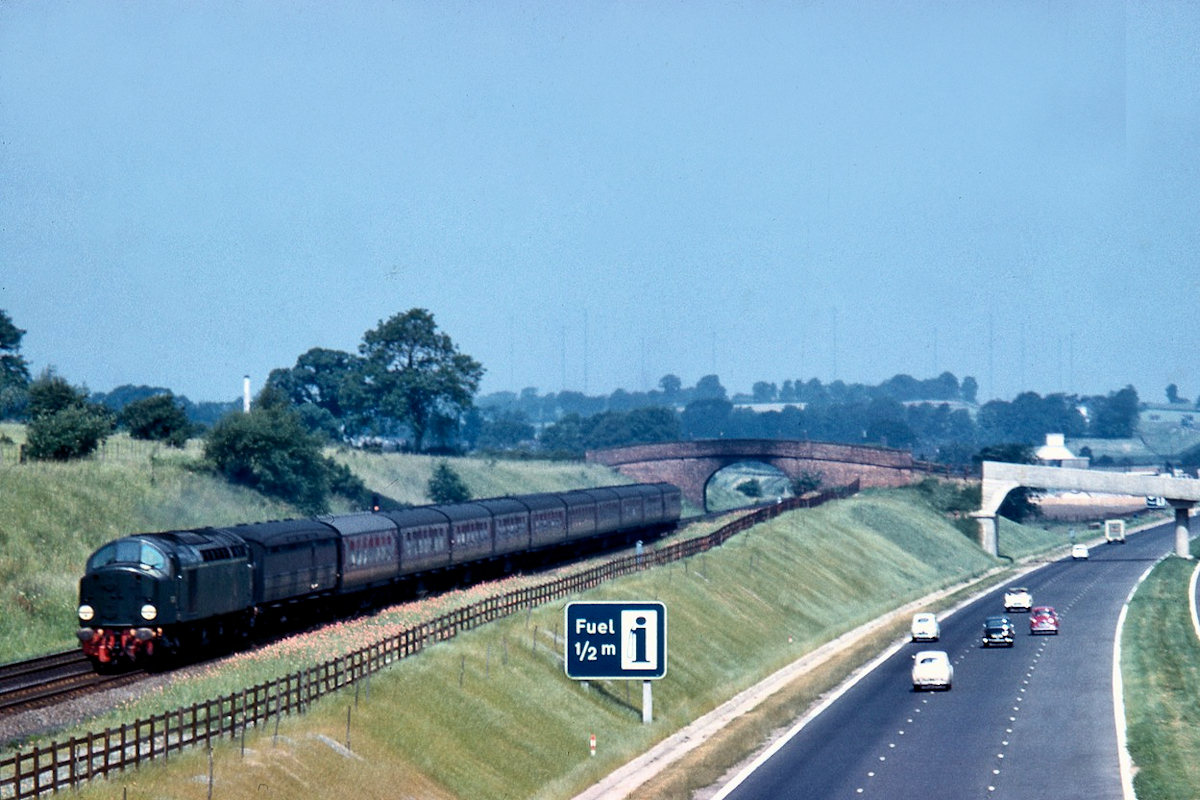9th April 2024 “An Evening with Father’s Slides” by David Cross

On Tuesday 9th April 2024 we welcomed David Cross for his eagerly-anticipated talk entitled “An Evening with Father’s Slides”. David gives around six talks per year from his late father Derek Cross’s collection and this evening’s was a black-and-white selection from London to Carlisle in the period from 1958 to 1968, focusing on steam. David remarked on the appropriateness of black-and-while for capturing steam photographs, not only from the artistic perspective but from the practical limitations of colour film in the 1950s being only 8ASA!
The images throughout the whole evening were Derek Cross at his best. Beautifully composed, classic steam photographs – unsurprisingly dominated by Stanier Pacifics in a talk such as this! Starting in London we saw Coronation Class 8P 4-6-2 No. 46245 ‘City of London’ on the Down Caledonian at South Kenton – a working limited to 8 carriages for the seven-and-a-quarter hour run to Glasgow. This was followed by Britannia Class 7P No. 70043 ‘Lord Kitchener’ on a Euston to Blackpool working and an example of suburban traffic in the form of Fairburn Class 4 2-6-4T No. 42099 on a stopper to Tring. Goods traffic was shown in the form of former LNWR Class 7F 0-8-0 No. 49441 passing Headstone Lane with early examples of containers on vacuum-fitted flats coupled next to the engine.
A short detour was made to the Midland Main Line where characteristic traffic of the period was seen: Up coal behind BR Class 9F 2-10-0 No. 92059 in July 1959, rebuilt Patriot Class 7P 4-6-0 No. 45526 ‘Morecambe and Heysham’ on a St. Pancras to Leeds working and Jubilee Class 6P/5F 4-6-0 No. 45616 ‘Malta G.C.’ on a St Pancras to Manchester train.
Returning to the LNWR Main Line, 46256 ‘Sir William A. Stanier FRS’ was pictured in 1960 on the Down ‘Royal Scot’ at Daventry with 14 carriages in tow, after which we visited Baddesley Colliery to see Gorton-built 0-4-0+0-4-0 Garrett ‘William Francis’ which worked the ferocious 1-in-23 gradients from the main line up to the colliery.
Crewe was our next port-of-call where we saw the wealth of traffic that passed through the station, including the several Pacifics on main line duties and a delightful view of ‘Royal Scot’ Class 7P No. 46110 ‘Grenadier Guardsman’ on a cross-country Manchester to Birmingham working. After Crewe we took a number of diversions including a run out to Chester and GWR Collett 2800 Class 2-8-0 No. 3849 climbing the 1-in-82 of Gresford Bank with a goods train to Shrewsbury, Stanier 8F 2-8-0 No. 48739 getting to grips with the Central Wales line on a Down goods at Knucklas in July 1964 and on the Lickey Incline LNER B1 No. 61041, banked by a pair of Panniers on a holiday train heading for Sheffield in the Summer of 1964. Our detour finished with a look at North Wales, featuring Britannia No. 70026 ‘Polar Star’ on the Down Irish Mail at Conway Castle in 1964, the ‘Cambrian Radio Cruise’ (Llandudno-Rhyl-Corwen-Barmouth-Caernarfon-Llandudno) at Penmaenmawr in August 1960 behind BR Standard Class 4 4-6-0 No. 75053 and the Up Cambrian Coast Express at Talerddig behind 75053 and 75016 in August 1966.
Back on the Main Line saw views at Preston, Lancaster, Morecambe Promenade, Carnforth and Oxenholme before reaching Derek’s favourite stretch of line over Shap. At Dillicar troughs we saw Coronation Class Pacific No. 46256 on the Up ‘Royal Scot’ and at Tebay, Britannia Class 7P No. 70052 ‘Firth of Tay’ on a Glasgow-Manchester Victoria working, including a six-wheeled restaurant car. A further small detour was taken to visit Kirkby Stephen East with BR Standard/Ivatt Class 4 2-6-0 double-header 76024 and 43129 on a Sumer Saturday South Shields and Darlington to Blackpool. A brief look at the Settle and Carlisle then gave us Jubilee 45640 ‘Frobisher’ on the Up Thames-Clyde Express at Ais Gill, ‘Royal Scot’ No. 46115 ‘Scots Guardsman’ on its very last run in August 1965 and 9F 92056 on a Long Meg to Widnes anhydrite working.
Returning to Tebay we saw a number of Pacifics on main line expresses, and then on to Scout Green where David recounted his childhood experiences of camping by the lineside, in full view of the daily procession of heavy trains banked up from Tebay. The photographs on this section of line were some of Derek’s finest and included Black 5 No. 44731 on a late evening Southbound parcels in July 1965, Britannia No. 70052 ‘First of Tay’ on the 4.30 pm Glasgow to Manchester Victoria and gas turbine locomotive GT3 on a test run to Penrith.
At Shap, 46254 ‘City of Stoke on Trent’ worked the Northbound ‘Royal Scot’ unassisted over the summit and we saw the only diesel of the evening – D8007 on a test train in late 1958. After Eden Valley Junction we briefly visited the Keswick branch with Class 4 2-6-0s 43120 and 43121 double-heading a Manchester to Keswick train, before the run in to Penrith and its magnificent LNWR lower-quadrant signals. David commented on how busy places like Penrith (and Oxenholme) used to be, with main line trains, branch trains, freight trains and all the associated movements around the junctions. Our final port of call was Carlisle, with 0-6-0 3F No. 47295 as station pilot in August 1962, light engines in the centre roads at the South of the station as Scottish engines came off and the lovely sight of V2 No. 60955 coming off the Dundee to Blackpool in August 1965 and A2 No. 60522 ‘Straight Deal’ on a parcels to Glasgow in August 1964.
The evening ended with huge applause to David for an enthralling collection of his father’s slides covering a priceless period of the final years of main line steam operation on the Euston-Carlisle main line.
